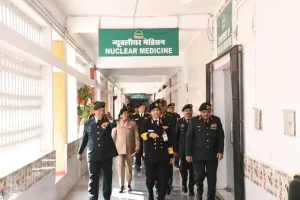MoD releases draft Defence Production and Export Promotion Policy 2020
- In order to provide impetus to self-reliance in defence manufacturing, multiple announcements were made under ‘Atmanirbhar Bharat Package’.
- In implementing such framework and to position India amongst the leading countries of the world in defence and aerospace sectors, Ministry of Defence (MoD) has formulated a draft Defence Production and Export Promotion Policy 2020 (DPEPP 2020). The DPEPP 2020 is envisaged as overarching guiding document of MoD to provide a focused, structured, and significant thrust to defence production capabilities of the country for self-reliance and exports.
- The policy has laid out following goals and objectives:
- To achieve a turnover of Rs 1,75,000 Crores (US$ 25 Billion) including export of Rs 35,000 Crore (US$ 5 Billion) in Aerospace and Defence goods and services by 2025.
- To develop a dynamic, robust, and competitive Defence industry, including Aerospace and Naval Shipbuilding industry to cater to the needs of Armed forces with quality products.
- To reduce dependence on imports and take forward “Make in India” initiatives through domestic design and development.
- To promote export of defence products and become part of the global defence value chains.
- To create an environment that encourages R&D, rewards innovation, creates Indian IP ownership and promotes a robust and self-reliant defence industry.
- The Policy brings out multiple strategies under the following focus areas:
- Procurement Reforms
- Indigenization & Support to MSMEs/Start-ups
- Optimize Resource Allocation
- Investment Promotion, FDI & Ease of Doing Business
- Innovation and R&D
- DPSUs and OFB
- Quality Assurance & Testing Infrastructure
- Export Promotion
No compromise on territorial integrity, says India in 5th round of military talks with China
- The Indian army has categorically conveyed to China’s PLA at the fifth round of military talks it will not compromise on India’s territorial integrity, and clearly said disengagement of troops from Pangong Tso and a few other friction points in eastern Ladakh should be completed at the earliest, people familiar with the developments said on Monday.
- Senior commanders of the two armies held intense negotiations for nearly 11 hours on Sunday at a designated meeting point in Moldo on the Chinese side of the Line of Actual Control (LAC).
- The Indian delegation very clearly and firmly communicated to the Chinese side that restoration of status quo ante in all areas of eastern Ladakh was key for overall ties between the two countries, and that Beijing must ensure complete disengagement of its troops from the remaining friction points, according to the people familiar with the developments.
- It was also categorically conveyed that the Indian army will not compromise on the country’s territorial integrity, they said.
- The Chinese army has pulled back from Galwan Valley and certain other areas but the withdrawal of troops has not moved forward from the Finger 4 and 8 areas in Pangong Tso as demanded by India. The mountain spurs in the area are referred to as Fingers. China also has not completed withdrawal of troops from Gogra areas.
- The focus of the Sunday talks was on finalising the modalities for further de-escalation, and disengagement of troops from various friction points, sources said, adding both sides were to discuss details of the negotiations with their respective military and political leadership.
- The sources said Army Chief Gen MM Naravane was given a detailed briefing about the talks on Monday morning which was subsequently followed by a discussion he held with senior military officials on the overall situation in eastern Ladakh.
- It is learnt that National Security Advisor Ajit Doval and External Affairs Minister S Jaishankar were also apprised about the talks, and the entire military and strategic brass tasked to deal with the border row is deliberating on various aspects of the overall situation.
- The Indian delegation was led by Lt Gen Harinder Singh, the commander of the Leh-based 14 Corps, while the Chinese side was headed by Major General Liu Lin, commander of the South Xinjiang military region. The previous round of the Corps Commander-level talks took place on the Indian side of the LAC on July 14 and it lasted for nearly 15 hours.
- There was no official word on details of the meeting.
- The military talks took place 10 days after both sides held another round of diplomatic parleys on the border issue.
- After the diplomatic talks, the Ministry of External Affairs(MEA) said both sides agreed that an early and complete disengagement of the troops along the LAC in accordance with bilateral agreement and protocols was essential for the overall development of bilateral relations.
- Last week, India rebutted China’s claim that the disengagement process was completed at most locations.
- “There has been some progress made towards this objective, but the disengagement process has as yet not been completed,” MEA spokesperson Anurag Srivastava said when asked about China’s claim.
- In the last three weeks, India has significantly ramped up troops and weaponry in the areas around Daulat Beg Oldi (DBO) and Depsang Valley in commensurate with deployment of troops by China’s People’s Liberation Army(PLA).
- During the military and diplomatic talks, India has also been demanding withdrawal of Chinese troops from Depsang, the area where they had intruded in 2013.
- The transgressions had created military and diplomatic tensions but was resolved after hectic rounds of negotiations following which the Chinese troops withdrew.
- India began sending reinforcements to Depsang and the areas around DBO in mid-May when tension between the two sides gradually escalated, and the deployment has been significantly ramped up with several thousand troops, tanks and artillery guns in the last two months, sources said.
- The formal process of disengagement of troops began on July 6, a day after a nearly two-hour telephonic conversation between NSA Doval and Chinese Foreign Minister Wang Yi on ways to bring down tension in the face-off points.
- The first round of the Lt General talks was held on June 6 during which both sides finalised an agreement to disengage gradually from all the standoff points beginning with Galwan Valley.
- However, the situation deteriorated following the Galwan Valley clashes on June 15 in which 20 Indian Army personnel were killed as the two sides significantly bolstered their deployments in most areas along the LAC.
- The Chinese side also suffered casualties in the clashes, but it is yet to give out the details. According to an American intelligence report, the number of casualties on the Chinese side was 35.
- The second round of military talks took place on June 22.
- At the third round of military talks on June 30, both sides agreed on an “expeditious, phased and step wise” de-escalation as a “priority” to end the standoff.
- Following the Galwan Valley incident, the govt. has given the armed forces “full freedom” to give a “befitting” response to any Chinese misadventure along the LAC.
- The Indian Air Force(IAF) has also moved air defence systems as well as a sizable number of its frontline combat jets and attack helicopters to several key air bases.
DRDO offers two options to develop an Indian light tank
- Last July, the Indian Ministry of Defence fast-tracked the emergency purchase of light tanks to counter possible attacks by over 20,000 Chinese troops poised on the Ladakh border along with tanks, artillery, air defence and road construction units.
- To eliminate the costly and time-consuming import of light tanks, the Defence R&D Organisation (DRDO) has developed plans for building an indigenous light tank for use in mountains and in jungle terrain.
- Arrayed on the Ladakh border is the People’s Liberation Army’s (PLA’s) new light tank, the small, agile and versatile ZTQ 105 – also known as the Type 15 tank. To counter these, India’s Ladakh garrison has just three tank regiments with a total of 150 old T-72 tanks that, with some 42 tonnes, are designed for the plains. Movement on mountain roads is slow and often impossible. Given the limited elevation and depression of its heavy gun, the T-72 cannot engage targets on hilltops and in valleys.
- Let us remind that Indian, British and U.S. troops used light tanks in their fight against the Japanese in North-eastern India and Burma during World War 2, the light tank being the U.S.-made M3/M3A1 Stuart delivered in the framework of the extraordinary Lend-Lease Act signed in 1941.
- They also used M3 Grant medium tanks and, later, M4 Sherman medium tanks, also supplied by the U.S. In 1948 these same Shermans pushed back Pakistan forces in the Zojila pass. Against China in 1962, the army used French-made AMX-13 light tanks in the battle of Gurung Hill near Pangong Tso and also deployed them in Bomdila and Dirang in Arunachal Pradesh. In the 1971 Bangladesh campaign, French AMX-13 and Soviet PT-76 amphibious tanks played a stellar role in the battle of Garibpur.
- Hence, Business Standard learns the DRDO has short-listed two options for developing an indigenous light tank within 18 months. Both these involve combining the DRDO’s tank development expertise created while developing the Arjun tank, with the defence manufacturing capability of companies such as Larsen & Toubro that are already building the K9 Vajra self-propelled gun system.
- The first option involves creating a 34-35-tonne tank by fitting a 105mm John Cockerill turret onto a K-9 Vajra hull, powered by a 1,000 hp MTU engine optimised for high altitudes. DRDO sources say this hybrid tank could go into production within 18 months.
- The second option retains the K-9 Vajra hull and MTU engine but matched with the gun turret of the T-90S Bhishma tank that the army already uses. This 38-tonne tank would also require 18 months for going into production.
- Larsen & Toubro is assembling the K-9 Vajra under licence from South Korea and will deliver its current order by next year. If the K-9 Vajra chassis is to form the basis for an Indian light tank, it would have to extend that licence.
- The DRDO is confident that either of these hybrid tanks would be better options than what the MoD is considering buying: the Russian Sprut SDM1. They point out that the Sprut is a tank destroyer with old technology and that no other country has bought it. Since the Russian army has bought only 24 Spruts, it is not in regular production, making it hard to meet early delivery schedules and Russia would have to be approached for spares, overhaul, and future upgrades.
- The DRDO has earlier attempted to develop light tanks, but there was never any real interest from the army. In the 1980s, the DRDO integrated the chassis of the Soviet BMP-1 infantry combat vehicle with a 105mm gun, but the army was not interested. Next, the DRDO mounted a French GIAT TS-90 turret and a 105mm gun on the BMP chassis, which the Ordnance Factory Board was building in Odisha.
- Again the army was indifferent, and the project was shelved. In 2009, the army’s interest in light tanks was renewed with the sanction of two armoured brigades for high altitude operations alongside the mountain strike corps. The army issued a request for information (RFI) in 2009, but eventually T-72 tanks were deemed adequate and the RFI was abandoned.
- Now, there is fresh interest with the possibility of encountering the Chinese new ZTQ 105 light tank. The VT5, also named Type 15 or ZTQ-15 in the Chinese army, is a lightweight battle tank designed and manufactured by NORINCO (China North Industries Corporation). The VT5 was unveiled to the public during the Zhuhai Air Show China in November 2016.
- According to NORINCO engineers, the VT5 was developed for the export market. The VT5 has a weight from 33 to 36 tons depending on the armour fitted to the tank. With this weight, the tank offers more mobility than a standard main battle tank offering the same level of firepower. The power-to-weight ratio is between 27 and 30 hp/ton depending on the armour package. This tank can be used in mountain areas and operate in terrains that are inaccessible to standard main battle tanks weighing around 50 tons.
- The VT5 features good battlefield awareness, strong information capabilities and high manoeuvrability. It is suitable for modern joint operations, according to NORINCO. On December 27, 2018, the spokesperson for the Chinese Ministry of National Defense Wu Qian announced that the new Type 15 lightweight tank was commissioned by China’s army. Type 15 was shown for the first time to the public during the military parade rehearsal for the 70th anniversary of the founding of the People’s Republic of China on September 2019. According to information published in December 2019, the Bangladesh Ministry of Defense officially announced that its army has ordered VT5 light tanks from China.
Russia offers India Sprut lightweight tanks amid stand-off with China
- Russia has offered India its 18-tonne Sprut SDM1 lightweight tanks for possible procurement amid the ongoing stand-off with China in eastern Ladakh.
- Sources said the offer for Spruts, capable of being airlifted, was made during Defence Minister Rajnath Singh’s visit to Russia in June.
- The move came as India has deployed heavy T-90 tanks, weighing about 46 tonnes, in Ladakh, besides T-72 tanks, which weigh around 45 tonnes; were deployed earlier.
- China, meanwhile, has deployed its new lightweight tanks, Type 15, which weigh around 33 tonnes.
- Lightweight tanks allow faster mobility in mountainous terrain than regular battle tanks that weigh over 40 tonnes.
- During Rajnath Singh’s visit, New Delhi and Moscow prepared a list of items that could be bought and sold in wake of the tensions at the Line of Actual Control (LAC).
- The lightweight tank didn’t feature in India’s demands but was part of the Russian offer, said the sources.
- However, some sources said the technical discussions are ongoing between the Indian embassy in Moscow and Russian authorities. Under technical discussions, both sides talked about the technical aspects of the weapons system to understand its capabilities and limitations.
- But defence sources maintained that no emergency procurement is planned for these lightweight tanks currently.
The interest in lightweight tanks:
- The need for light weight tanks has been noted in the past too, but the Army’s interest in it comes in the wake of tensions with China.
- In 2009, the Army had issued a Request for Information (RFI) for 200 wheeled and 100 tracked light weight tanks for the new Mountain Divisions then being raised.
- Now, the government-run Defence Research and Development Organisation (DRDO) is reportedly working on lightweight tanks. Reports suggest the DRDO is in talks with private company Larsen & Toubro for converting the K9 ‘Vajra’ 155 mm self-propelled howitzer into a 35-tonne light weight tank.
- According to the planned DRDO design, the K9’s 155/52 mm howitzer will be replaced by a modular turret and 105 mm gun made by Belgian firm John Cockerel Defence SA. The gun is capable of firing at 42-degree elevation, which would be helpful in a mountain warfare scenario.
- If the project fructifies, the L&T’s production line of Vajra would be used to produce these tanks. The production line in Surat is set to go idle by the end of this year when the 100th Vajra is delivered under the contract.
- In the past, India had lightweight tanks that were used during the 1947-48 Kashmir operations and then the 1962 and 1971 wars. However, these later paved the way for heavier tanks.
As Mountain Stand-Off with India Continues, China Stages Bombers and Cruise Missiles
- The Chinese air force apparently has deployed bombers to an air base in the country’s far west, placing the warplanes within striking distance of Indian forces along the disputed Chinese Indian border in the Himalayas.
- But conditions undoubtedly are difficult for the bombers and their crews.
- Commercial satellite imagery depicting six H-6 bombers on the tarmac at Kashgar airport in the Uyghur autonomous region of Xinjiang.
- The H-6 is a Chinese development of the twin-engine Soviet Tu-16 medium bomber. Chinese industry has greatly improved the basic Tu-16 with new sensors, avionics, engines, and weapons.
- Kashgar lies around 500 miles from Ladakh, the region of northern India along which runs the Line of Actual Control, the demarcation between Indian and Chinese forces in the Himalayas. Diplomats drew that line as part of truce talks following a bitter, bloody border war in 1962.
- It is unclear when the H-6s arrived in Kashgar, but it could be as recently as July, based on the dates on the satellite imagery.
- In early June, Chinese forces killed 20 Indian soldiers in a skirmish along the Line of Actual Control. Forty-three Chinese soldiers also were injured or died, according to press reports.
- Indian and Chinese warplanes and helicopters are patrolling the border zone as the stand-off continues. India has deployed Su-30, MiG-29 and MiG-29K fighters. Satellite imagery depicts Chinese air force J-16 fighters sharing the tarmac with the H-6s at Kashgar.
- The satellites photos of the bombers appear to depict what aviation-expert Andreas Ruprecht surmised to be KD-63 land-attack cruise missiles under the H-6s’ wings. The KD-63 boasts a range of around 125 miles.
- India and China’s bases near the Line of Actual Control lie many thousands of feet above sea level. Kashgar is situated an eye-watering 14,500 feet above sea level.
- The high, thin air can pose challenges to combat aircraft. A lack of lifting power can reduce payload on fighters to minimal fuel and just a few small missiles. Bombers could face some of the same constraints.
- Less fuel means less range. For the Chinese, aerial refuelling is not really an option, as the Chinese air force operates at most a couple dozen tanker planes.
- All that is to say, western China—especially the Himalayas with their 20,000-foot peaks—is a less-than-ideal zone for air-combat operations.
Chinese Army’s cyber-attack unit eyeing information on India’s defence and research, warn security agencies
- The Chinese Army’s secret unit ‘61398’, known for cyber espionage, is eyeing information related to India’s defence and research, the security agencies sounded an alert on Monday. According to a report of the security agencies, this secret unit of the People’s Liberation of Army (PLA) has intensified its activities against India.
- Many cases have been reported in the last few months in which Chinese hackers associated with the PLA attempted to gather sensitive information of the country through cyber espionage.
- Headquartered in Datong Avenue of Pudong district in China’s Shanghai, unit ‘61398’ is witnessing a spurt in these activities, asserted an officer deployed in the central security. “Through unit ‘61398’, China has been engaged in gathering information like cyber, space and geolocation intelligence around the world for a long time. These units are found to be highly active against India,” said the officer.
- Since 2015, PLA has centralized its space, cyber and electronic warfare (EW) assets in the newly raised PLA Strategic Support Force (PLASSF). Therefore the unit ‘61398’ which deals with cyber warfare and was under erstwhile 3 PLA (General Staff Department Third Department) have been subordinated under the network system department of the PLASSF.
- Another officer who is aware of the development said that there is a report of at least three cyber hackers supporting cyber espionage activities. Recently, there have been attempts made by these hackers to send a special computer programme worldwide by attaching malware tools to cyber espionage. Ice bug, Hidden Lynx (a professional advanced persistent threat using the program) and APT-12 have been used for attacking government and industrial organization by Chinese hackers.
- In 2014, the US had charged five PLA military officers for espionage and they were part of unit ‘61398’. The US agencies believe that, like Unit ‘61398’, many such groups exist in China with the active support of the PLA, who are engaged in cyber spying around the world.
- Many analysts believe China now has the capability to successfully target critical infrastructure during the war. There is also concern that Chinese hackers may disrupt the electric grid and banking system through cyber-attacks.
REVIEW QUESTIONS
- The Defence Production and Export Promotion Policy 2020 is to achieve a turnover of ____ rupees including export of ____ rupees in Aerospace and Defence goods and services by the year of 2025.
- Rs 1,65,000 Crores; Rs 45,000 Crores
- Rs 1,75,000 Crores; Rs 35,000 Crores
- Rs 1,85,000 Crores; Rs 55,000 Crores
- Rs 1,95,000 Crores; Rs 65,000 Crores
ANSWER: B
- Consider the following statements regarding DPEPP 2020:
- DPEPP is aimed to develop a dynamic, robust, and competitive Defence industry, including Aerospace and Naval Shipbuilding industry to cater to the needs of Armed forces with quality products.
- It reduces dependence on imports and take forward “Make in India” initiatives through domestic design and development.
Which of the statements given above is/are correct?
- 1 only
- 2 only
- Both 1 and 2
- Neither 1 nor 2
ANSWER: C


















